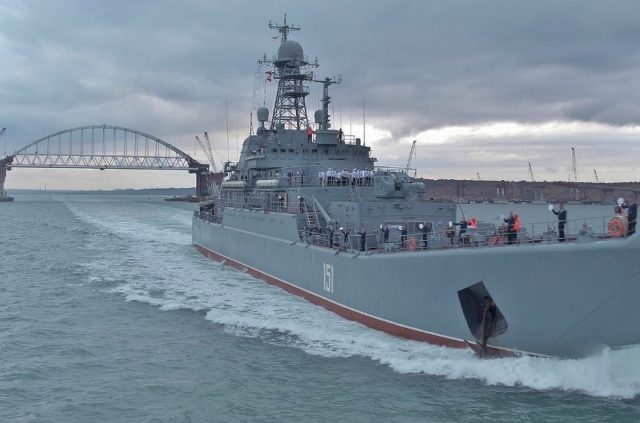
Azov Sea, Kerch Strait: Evolution of Their Purported Legal Status (Part Three)
Publication: Eurasia Daily Monitor Volume: 15 Issue: 173
By:

*To read Part One, please click here.
*To read Part Two, please click here.
Russia’s 2014 seizure of Crimea and the resulting de facto border changes have overturned the geographical and political foundations of the 2003 Russia-Ukraine treaty on the Azov Sea and Kerch Strait. The consequences of the 2014 fait accompli with regard to Ukraine’s position in that sea and in that strait escaped Western notice until now. Those consequences include Russia’s de facto annexation of the Kerch Strait and threat of de facto annexation of the surface of the Azov Sea. Springing yet another strategic surprise on Ukraine and its international partners, Russia recently assembled a strong Azov Sea flotilla and began, in May 2018, systematically to obstruct shipping in the Kerch Strait and Azov Sea. The November 25, 2018, Russian attacks on Ukrainian ships occurred as an epiphenomenon of that process, belatedly drawing international attention after triggering a crisis (see Parts One and Two in EDM, December 3, 5).
At present, the rules in this theater seem basically to be what Russia says they are. Russia is in a position unilaterally to determine which treaty provisions no longer apply at all since 2014, or apply partly or selectively, or yet apply from time to time on a case by case basis. The case-by-case approach seems to be the name of Russia’s game (see below).
Russia’s recent actions in the Azov Sea and Kerch Strait, respectively, reflect two different starting premises: 1) The 2003 treaty continues to apply in the Azov Sea because it operates to Russia’s advantage in that “shared” sea, and 2) The treaty no longer applies to the now-“Russian” Kerch Strait, but Russia is willing to allow Ukraine (and Ukraine’s commercial partners) to use that strait within certain limitations, at Russia’s discretion.
The treaty’s definition of the Azov Sea as a shared (common) interior sea remains in effect because Russian power can enforce it. This status provides Russia with a pseudo-legal argument for “squeezing” Ukraine’s maritime presence, restricting it to the immediate proximity of Ukraine’s own coast whenever Russia so chooses, as long as there is no maritime border, no territorial waters and no national sectors or exclusive economic zones in the Azov Sea. According to Ukrainian State Border Service and Coastal Guard officials, Russian ships in the Azov Sea may, in principle, approach the Ukrainian coast all the way, just short of physically touching the shore. According to those Ukrainian officials, Moscow would not technically have to admit to a violation, unless the boots of Russian sailors or soldiers would (hypothetically) step onto the Ukrainian shore (Kyiv Post, May 20, June 15).
Drawing a border between Russian and Ukrainian waters in the Azov Sea (as the bilateral treaty did envisage) is no longer an option for Ukraine. With Crimea in Russia’s hands, any bilateral division of the Azov Sea would: a) inevitably signify Ukrainian recognition of Crimea’s annexation by Russia, and b) award Russia by far the largest portion of the sea, due to the length of Crimea’s coastline in Russia’s possession. In any case, Russia has demonstrated this year that it can turn most of the Azov Sea’s surface into a Russian lake de facto. Russia continues availing itself of the 2003 treaty, maintaining the fiction of a shared sea, which purportedly allows freedom of Russian military movements throughout the non-delimited (borderless) Azov Sea (see Part Two).
In the Kerch Strait, by contrast, Russia insists that the 2003 treaty no longer applies, having been superseded by Russia’s 2014 incorporation of Crimea, which in Moscow’s view turned the “shared” Ukrainian-Russian waterway into a fully sovereign Russian internal waterway.
Russia, however, has not announced its withdrawal from the treaty’s provisions relevant to the Kerch Strait (or any other provisions of that treaty). On the contrary, Moscow insists that the 2003 treaty cannot be denounced or abrogated by either side. This thesis is designed to exploit the treaty in Russia’s interest in the Azov Sea, binding a powerless Ukraine to the treaty there (see above), while at the same time terminating the treaty in the Kerch Strait de facto, though not de jure. Without ever declaring that treaty invalid, Moscow argues that Russia’s “sovereignty” over the Kerch Strait since 2014 takes precedence over the 2003 treaty with Ukraine (turning the “rebus sic stantibus” on its head in the process). With this, Russia reserves the right to establish limitations and restrictive rules for Ukrainian and international shipping through the Kerch Strait.
Those impediments are to be applied intermittently and selectively, using the case-by-case approach. The goal is not to block access outright for any length of time (a “blockade” of the strait), but to limit and manipulate the access through the Kerch Strait, and thereby to Ukraine’s ports on the Azov Sea. Such tactics can generate negotiating leverage and a variety of options for Russia to threaten Ukraine.
The Russian navy’s stop-and-search detentions of commercial ships in the Azov Sea from May through November this year have inflicted significant economic losses on Ukrainian ports and international shippers. Russian detentions of ships at either end of the Kerch Strait, however, have been even more damaging to those Ukrainian ports and the shippers plying them. According to Ukrainian analysts at the Institute of Strategic Black Sea Studies, Russian on-the-move vessel detentions in the Azov Sea have resulted in delays averaging two to three hours per ship, whereas detentions/inspections of ships at either end of the Kerch Strait have resulted in delays that grew from three days to five days per ship between May and November (“Russia’s Economic War against Ukraine in the Kerch Strait and Azov Sea,” Institute of Strategic Black Sea Studies, December 1).



